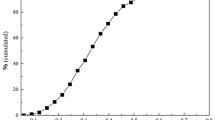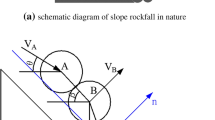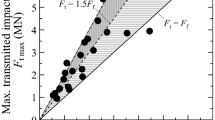Abstract
A gravel cushion is an effective method for preventing rockfall disasters, but the thickness and particle size of cushion influence the impact response between rockfall and cushion. Based on previous indoor experiments, a numerical model of a rockfall impacting a cushion was built, and the accuracy of the model were verified by comparing with the coefficient of restitution obtained from experimental results. Then, the impact response characteristics during collision between rockfall and cushion, including the impact force on the cushion surface, the impact force on the cushion bottom, and the penetration depth, were studied. It was found that decreasing the cushion thickness can only reduce the impact force on the cushion bottom, while decreasing the particle size of the cushion can reduce both the impact forces on the cushion surface and bottom. With an increase in the falling height of rockfall, both of the impact forces on the cushion surface and bottom consistently increase, and the increase rate of the impact force on the cushion surface is higher than that of the impact force on the cushion bottom. The penetration depth is significantly affected by the particle size of cushion. With an increase in the falling height of rockfall, the penetration depth increases, but when the particle size of cushion is relatively large, the influence of the falling height of rockfall on the penetration depth decreases to some extent. These numerical results provide a widely applicable theoretical foundation for gravel cushions against rockfall disasters.














Similar content being viewed by others
Availability of data and material
All the data, models, or code that support the findings of this study are available from the corresponding author upon reasonable request.
References
Agliardi F, Crosta GB (2003) High resolution three-dimensional numerical modeling of rockfalls. Int J Rock Mech Min Sci 40:455–471
Alejano LR, Stockhausen HW, Alonso E et al (2008) ROFRAQ: a statistics-based empirical method for assessing accident risk from rockfalls in quarries. Int J Rock Mech Min Sci 45(8):1252–1272
Alejano LR, Pons B, Bastante FG et al (2007) Slope geometry design as a means for controlling rockfalls in quarries. Int J Rock Mech Min Sci 44(6):903–921
Chen JT, Zhao JH, Zhang SC, Zhang Y, Yang F, Li M (2020) An experimental and analytical research on the evolution of mining cracks in deep floor rock mass. Pure Appl Geophys 2020(1):1–24. https://doi.org/10.1007/s00024-020-02550-9
Ferrero A, Migliazza M, Pirulli M, Umili G (2016) Some open issues on rockfall hazard analysis in fractured rock mass: problems and prospects. Rock Mech Rock Eng 49:3615–3629
Gischig VS, Hungr O, Mitchell A, Bourrier F (2015) Pierre3D: a 3D stochastic rockfall simulator based on random ground roughness and hyperbolic restitution factors. Can Geotech J 52(9):1360–1373
Irfan M, Chen YL (2017) Segmented loop algorithm of theoretical calculation of trajectory of rockfall. Geotech Geol Eng 35(1):377–384
Jiang YJ, Wang ZZ, Song Y, Xiao SY (2018) Cushion layer effect on the impact of a dry granular flow against a curved rock shed. Rock Mech Rock Eng 51(7):2191–2205
Kim DH, Gratchev I, Berends J, Balasubramaniam A (2015) Calibration of restitution coefficients using rockfall simulations based on 3D photogrammetry model: a case study. Nat Hazards 78(3):1931–1946
Li LP, Sun SQ, Li SC et al (2016) Coefficient of restitution and kinetic energy loss of rockfall impacts. KSCE J Civ Eng 20(6):2297–2307
Liu GY, Li JJ (2019) A three-dimensional discontinuous deformation analysis method for investigating the effect of slope geometrical characteristics on rockfall behaviors. Int J Comput Methods 16(8):1850122
Liu DK, Gu ZL, Liang RX, Su JW, Ren DZ, Chen B, Huang CQ, Yang C (2020) Impacts of pore-throat system on fractal characterization of tight sandstones. Geofluids 2020(9):1–17, Article ID 4941501
Labiouse V, Heidenreich B (2009) Half-scale experimental study of rockfall impacts on sandy slopes. Nat Hazards Earth Syst Sci 9:1981–1993
Meng Q, Wang H, Cai M, Xu W, Zhuang X, Rabczuk T (2020) Three-dimensional mesoscale computational modeling of soil-rock mixtures with concave particles. Eng Geol 277, Article ID: 105802
Pichler B, Hellmich C, Mang HA (2005) Impact of rocks onto gravel design and evaluation of experiments. Int J Impact Eng 31(5):559–578
Pichler B, Hellmich C, Mang HA et al (2006) Loading of a gravel-buried steel pipe subjected to rockfall. J Geotech Geoenviron Eng 132(11):1465–1473
Perez-Rey I, Riquelme A, Gonzalez-deSantos LM et al (2019) A multi-approach rockfall hazard assessment on a weathered granite natural rock slope. Landslides 16(10):2005–2015
Rocscience (2016) RocFall 6.0 [Computer Software]. Retrieved from https://www.rocscience.com/
Shen WG, Zhao T, Dai F et al (2019) DEM analyses of rock block shape effect on the response of rockfall impact against a soil buffering layer. Eng Geol 249:60–70
Saroglou H, Marinos V, Marinos P, Tsiambaos G (2012) Rockfall hazard and risk assessment: an example from a high promontory at the historical site of Monemvasia, Greece. Nat Hazards Earth Syst Sci 12(6):1823–1836
Tao ZG, Zhu C, He MC et al (2017) Test of V shaped groove structure against rockfall based on orthogonal design. J China Coal Soc 42(9):2307–2315
Tao ZG, Zhu C, He MC, Liu KM (2020) Research on the safe mining depth of anti-dip bedding slope in Changshanhao Mine. Geomech Geophys Geo Energy Geo Resour 6(2):36
Wang SH, Ahmed Z, Hashmi MZ, Wang PY (2019) Cliff face rock slope stability analysis based on unmanned arial vehicle (UAV) photogrammetry. Geomech Geophys Geo Energy Geo Resour 5(4):333–344
Wang X, Liu C, Chen S, Chen L, Li K, Liu N (2020) Impact of coal sector’s de-capacity policy on coal price. Appl Energy 2020(265):114802
Xiong LX, Xu ZY et al (2020) Bonded-particle discrete element modeling of mechanical behaviors of interlayered rock mass under loading and unloading conditions. Geomech Geophys Geo Energy Geo Resour 5(1):1–16
Yang WM, Geng Y, Zhou ZW et al (2020) DEM numerical simulation study on fracture propagation of synchronous fracturing in a double fracture rock mass. Geomech Geophys Geo Energy Geo Resour 6(2):39
Youssef AM, Pradhan B, Al-Kathery M et al (2015) Assessment of rockfall hazard at Al-Noor Mountain, Makkah city (Saudi Arabia) using spatio-temporal remote sensing data and field investigation. J Afr Earth Sci 101:309–321
Zhang GC, Tang HM, Xiang X, Karakus M (2015) Theoretical study of rockfall impacts based on logistic curves. Int J Rock Mech Min Sci 78:133–143
Zhu C, Wang DS, He M et al (2018) The effects of gravel cushion particle size and thickness on the coefficient of restitution in rockfall impacts. Nat Hazards Earth Syst Sci 18(6):1811–1823
Zhu C, Tao ZG, Zhao S et al (2019) V shaped gully method for controlling rockfall of high-steep slope in China. Bull Eng Geol Environ 78(4):2731–2747
Zhu C, He MC, Karakus M, Cui XB, Tao ZG (2020) Investigating toppling failure mechanism of anti-dip layered slope due to excavation by physical modelling. Rock Mech Rock Eng 53(11):5029–5050
Acknowledgements
This work was supported by the Fundamental Research Funds for the Central Universities (No. B200202083), the Research and Development Project of Guizhou University of Engineering Science (No. G2018016), Open fund of Engineering Research Center of Development and Management for Low to Ultra-Low Permeability Oil & Gas Reservoirs in West China, Ministry of Education (No. KFJJ-XB-2020-7), and the Key Special Project of National Natural Science Foundation of China (No. 41941018).
Author information
Authors and Affiliations
Corresponding authors
Ethics declarations
Conflict of interest
No conflict of interest exists in the submission of this manuscript. The manuscript was approved by all authors for publication.
Additional information
Publisher's Note
Springer Nature remains neutral with regard to jurisdictional claims in published maps and institutional affiliations.
Rights and permissions
About this article
Cite this article
Zhu, C., He, M., Yin, Q. et al. Numerical simulation of rockfalls colliding with a gravel cushion with varying thicknesses and particle sizes. Geomech. Geophys. Geo-energ. Geo-resour. 7, 11 (2021). https://doi.org/10.1007/s40948-020-00203-8
Received:
Accepted:
Published:
DOI: https://doi.org/10.1007/s40948-020-00203-8




